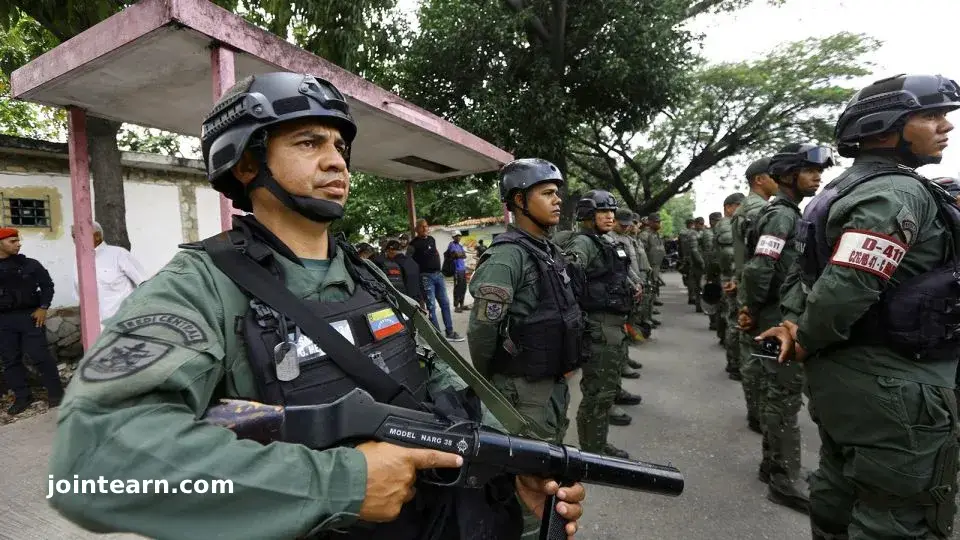
Caracas, November 11, 2025 — Venezuela has announced a large-scale military mobilization across land, sea, and air forces in response to what it calls an “imperialist threat” from the United States, following the arrival of America’s largest warship, the USS Gerald R. Ford, in the Caribbean Sea.
Venezuela Responds to U.S. Military Presence in the Caribbean
According to Venezuelan Defense Minister Vladimir Padrino López, the move comes under direct orders from President Nicolás Maduro. Padrino confirmed that Venezuela’s Bolivarian National Armed Forces and the Bolivarian Militia — a volunteer reserve force created by the late Hugo Chávez — will take part in what he called a “massive mobilization of troops, weapons, and equipment.”
The operation, set to continue through Wednesday, aims to strengthen Venezuela’s command, control, and communications systems and to prepare the country for what officials describe as an increasing threat from U.S. military forces in the region.
“This mobilization is a sovereign act to defend our homeland from imperial aggression,” Padrino López said during a televised statement.
The USS Gerald R. Ford Enters U.S. Southern Command Zone
The U.S. Navy confirmed earlier this week that the USS Gerald R. Ford, the most advanced and largest aircraft carrier in the world, has entered the U.S. Southern Command’s area of operations, which encompasses Latin America and the Caribbean.
Defense Secretary Pete Hegseth ordered the carrier strike group to move from Europe to the Caribbean late last month. The Ford’s accompanying strike group includes:
- Nine air squadrons,
- Two Arleigh Burke-class destroyers (USS Bainbridge and USS Mahan),
- The USS Winston S. Churchill, a missile defense command ship,
- And more than 4,000 U.S. sailors.
The U.S. government maintains that the increased presence is part of an anti-drug trafficking campaign, targeting narcotics routes in the Caribbean and South America. However, Venezuelan officials have accused Washington of using this justification as a cover for regime change efforts.
Rising U.S.-Venezuela Tensions
Relations between Washington and Caracas have deteriorated further in recent months. Former U.S. President Donald Trump confirmed in October that he had authorized limited CIA operations in Venezuela, raising concerns in Caracas of potential covert actions to undermine the Maduro government.
Although U.S. officials have denied any current plans for direct military strikes, the deployment of advanced assets — including F/A-18E Super Hornet fighter jets, F-35 stealth fighters, and MQ-9 Reaper drones — has fueled speculation that the United States is preparing for a stronger regional posture.
Maduro’s administration responded by activating its “Independence Plan 200”, a civic-military defense strategy designed to integrate conventional military forces with the Bolivarian Militia and local police to safeguard Venezuelan sovereignty.
Venezuela’s Military Strength and Challenges
Venezuela’s regular armed forces, the Bolivarian National Armed Forces (FANB), are estimated to have 123,000 active personnel, supported by a claimed 8 million reservists in the Bolivarian Militia.
However, analysts question both the accuracy of these figures and the preparedness of the militia. Many experts say that while the FANB retains modern weaponry — including Russian-made air defense systems and Chinese armored vehicles — it faces shortages of spare parts, limited air readiness, and low morale among troops due to economic hardship.
Despite these challenges, the Maduro government has positioned the mobilization as a demonstration of unity and deterrence against potential U.S. actions.
“Every soldier, every citizen, is part of our national defense,” said Padrino López. “The Bolivarian Republic of Venezuela will not bow to imperial intimidation.”
U.S. Forces Expand Presence in the Caribbean
With the arrival of the USS Gerald R. Ford, the United States now has approximately 15,000 troops stationed in and around the Caribbean region.
Other assets include:
- The Iwo Jima Amphibious Ready Group and the 22nd Marine Expeditionary Unit, adding 4,500 Marines and sailors,
- Three guided-missile destroyers, an attack submarine, a guided-missile cruiser, and a special operations ship,
- P-8 Poseidon reconnaissance aircraft monitoring regional movements,
- And F-35 fighter jets and Reaper drones deployed to Puerto Rico, which now serves as a strategic hub for U.S. operations in the Caribbean.
In late October, U.S. bombers reportedly conducted “attack demonstration” exercises off the Venezuelan coast — further heightening tensions between the two nations.
Maduro’s Political and Strategic Gamble
Analysts view Venezuela’s mobilization as both a military maneuver and a political signal. Facing continued economic sanctions and internal instability, President Nicolás Maduro seeks to rally nationalist support and portray Venezuela as a victim of foreign aggression.
Experts also suggest the mobilization could strengthen Maduro’s standing within the military, which remains a crucial pillar of his rule.
Meanwhile, Washington has reiterated that its focus remains on regional stability and counter-narcotics operations, though its actions have been widely interpreted as part of a broader strategy to contain authoritarian influence in the region.
Global Reactions and Regional Implications
Neighboring countries, including Colombia and Brazil, have expressed concern about escalating tensions between Venezuela and the United States. Both nations have increased surveillance along their borders and called for restraint.
Regional analysts warn that even a minor miscalculation — such as an airspace violation or naval encounter — could spark a serious military confrontation.
For now, both sides appear to be testing each other’s resolve, with Venezuela emphasizing sovereignty and the U.S. asserting freedom of navigation in international waters.
As the standoff continues, the Caribbean is once again becoming a focal point of geopolitical tension between Washington and Caracas, reminiscent of Cold War dynamics in Latin America.


Leave a Reply